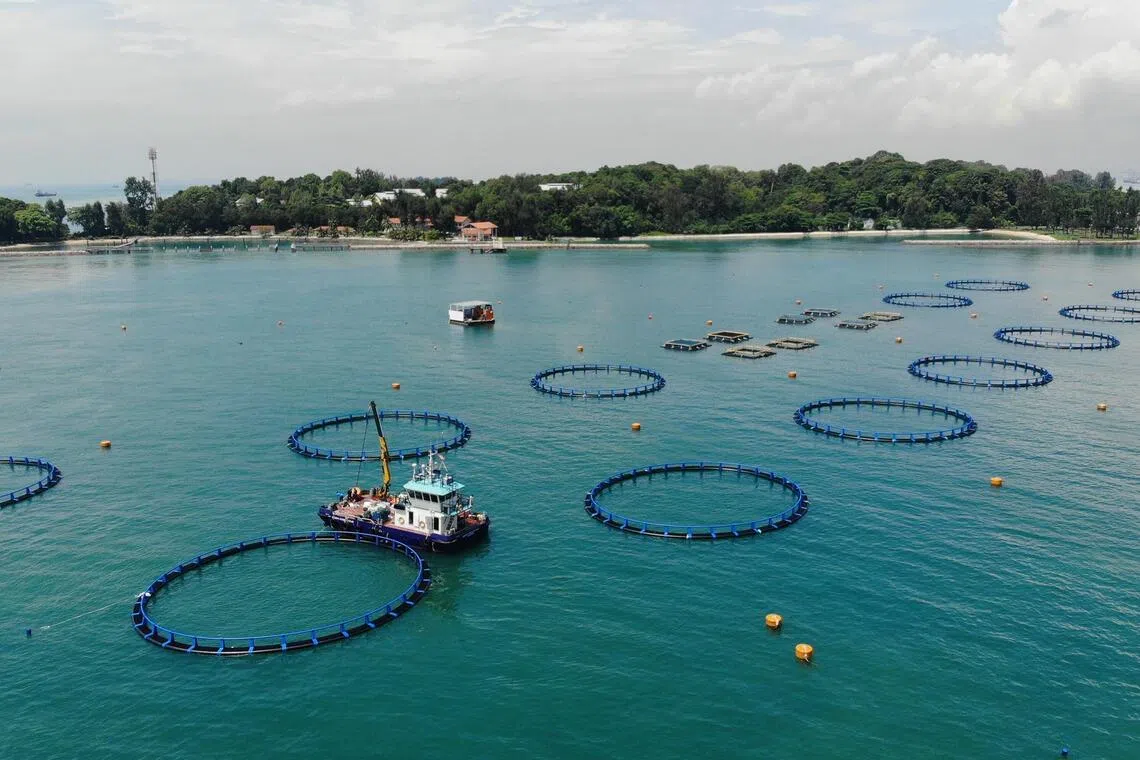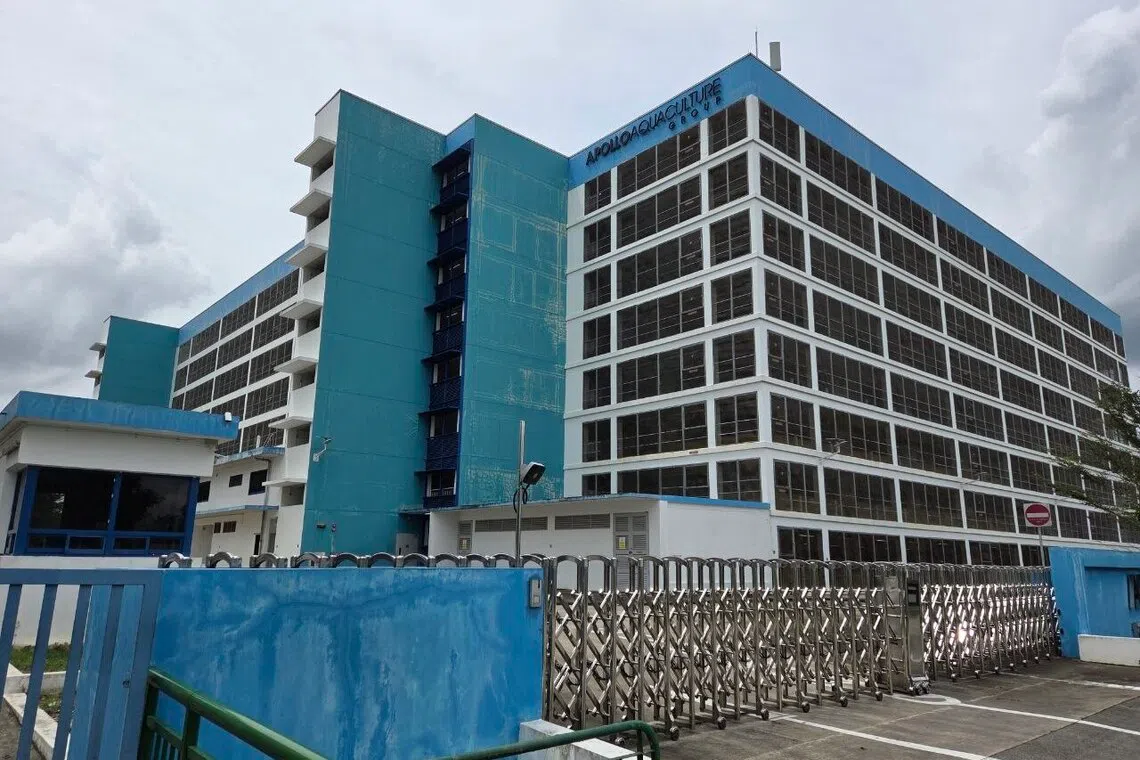SINGAPORE – Two fish farming facilities that had been given up by firms exiting the local aquaculture industry have been acquired by local companies to pursue new farming ventures, The Straits Times has learnt.
One is a $65 million eight-storey vertical farm once owned by Apollo Aquaculture Group, which
ran into financial difficulties in 2022
.
It has now been taken over by AquaChamp, a land-based fish farm operator, and local construction and engineering firm HPC Builders. The building at Neo Tiew Crescent in Lim Chu Kang will be used to grow vannamei prawn and food fish.
The other farming facility – open-net cages in Singapore’s southern waters once owned by Barramundi Group – will be taken over by Singapore Aquaculture Technologies (SAT), which operates indoor floating farms in the Johor Strait north of the mainland.
While its fishes are currently fully reared in closed-loop recirculating aquaculture systems on floating barges, SAT intends to shift to a hybrid farming model when it acquires the deep-sea cages off St John’s Island.
This means that the young Asian seabass reared in the barges – where farmed fish are kept from direct contact with the surrounding sea in indoor tanks – will be sent to the ocean cages to grow to harvest-size.
The latest developments show continued interest among local firms in producing food in Singapore, despite the setbacks plaguing the sector, with multiple farm closures reported since 2022.
On Nov 4, the Government said it will scrap the original 30 by 30 farming target of producing 30 per cent of food consumed in Singapore locally by 2030, for revised, scaled-down goals.
The aim now is to produce 20 per cent of the country’s consumed fibre, such as leafy vegetables, and 30 per cent of protein, including seafood and eggs, by 2035.
Apollo Aquaculture and Barramundi Group were among the high-profile farms in Singapore that had closed down or filed for liquidation in recent years.
On the new plans for the eight-storey structure in Lim Chu Kang, an AquaChamp spokesperson said the first six floors will focus on fish production, and vannamei shrimp will be farmed on levels seven and eight.
“We will utilise three storeys first, and gradually increase production level by level,” the spokesperson told ST.
Farming of fish and shrimp has started, said AquaChamp, after its engineering team installed the equipment and farming systems. It added that the amount of seafood currently farmed is “not too high”, as the company is still in the midst of revamping the recirculating aquaculture system.
It is also looking at selling ready-to-eat products to meet the needs of busy customers.
“The design is unique and built to suit our climate. We strongly believe in its potential, and will work hard to make this a proud Singapore brand,” said AquaChamp.
The firm’s management saw the potential and the benefits of farming in an eight-storey facility, and Apollo’s building was acquired “after much careful consideration”, said the spokesperson.
When it belonged to Apollo Aquaculture Group, the eight-storey farm began operations in 2021, when it was showcased as a high-tech farming solution that addressed the Republic’s land-scarcity constraints.
However, it had been lying dormant since the group ran into financial difficulties and was placed under judicial management in May 2022.
It was previously reported that the company’s financial challenges resulted largely from delays in the completion of the fish farm. The delays had resulted in escalating costs and, in turn, affected the group’s revenue and operations.
In 2024, ST reported that HPC Builders would purchase 70 per cent of Apollo Aquarium’s equity for not more than $3.5 million, while the remaining 30 per cent would be sold to AquaChamp.
As for Barramundi Group, the farm was hit by a
fish virus outbreak in 2023
that grounded its commercial operations.
It was later revealed that the group was
making plans to exit Singapore
and to focus on its operations in Brunei.
It was reported in July that Singapore’s court had approved a debt restructuring plan for Barramundi Group.
For SAT, the need to scale up operations in a cost-effective manner spurred the firm to take over the stranded nets off St John’s Island and have a portion of its farming done at sea.

Barramundi Group’s open cages off St John’s Island.
PHOTO: BARRAMUNDI GROUP
“Without scale in farming, you are not going to be successful, and we need to grow the largest-size fish for export. Large fish grown in RAS (recirculating aquaculture systems) are not as economical because the fish slows down in its growth rate. RAS is also expensive to run,” SAT co-founder and chief technology officer Michael Voigtmann told ST.
“A lot of money, time and effort was spent installing (Barramundi Group’s) assets. It would be a great shame just to leave that. We also have a different farming technique that gives us a better chance to be successful with those assets,” he added.
Barramundi Group’s open-sea cages off Pulau Senang and Pulau Semakau will not be taken over by SAT.
Dr Voigtmann did not disclose when SAT will move to the St John’s Island waters, but the company has been working on the move in the last year or so.
SAT will take over 10ha of the sea area, which will include the deep-sea cages, the two barges, floating solar panels and a battery storage barge. To improve the quality of fish farmed, the firm will also run a seabass hatchery and nursery at the Singapore Food Agency’s Marine Aquaculture Centre on the island.
SAT will continue growing red snapper and grouper at its indoor barge in the East Johor Strait.
Singapore’s waters are known to harbour viruses and parasites that affect fish mortality. Barramundi Group’s fish were affected by the scale drop disease virus, which can be fatal to seabass.
This is why SAT is planning to place the seabass in the open cages only after they have grown to a certain size in the enclosed barges.
Dr Voigtmann said: “The fish’s immune system will be more developed… By the time it is around 700g, it’s a pretty robust fish and has a much higher chance to be able to manage whatever it sees in the sea.”

